46% of Practices Are Already Using Chatbots To Assess Patient Symptoms, and That Number Is Going To Go Up
In November of 2022, OpenAI released its artificial intelligence chatbot, ChatGPT. Since then, the impressive performance of this generative AI tool has garnered tons of attention and speculation about its future potential.
In the medical community, ChatGPT has already been tested in a number of ways. Within days of its release, Dr. Cliff Stermer attempted to use ChatGPT to write an insurance appeal letter.[1] While that attempt proved the tool wasn't quite ready to complete tasks without human supervision, Doximity has since curated a library of prompts to help its subscribers use ChatGPT to write a variety of documents, including insurance appeals, progress notes, post-op instructions, referrals, etc.[2]
To keep pace with the surge of interest in medical chatbots, we conducted our 2023 medical chatbots survey to understand how practices are using these tools and how providers expect technological advancements to serve healthcare professionals and patients in the future.*
How our research helps
Using our findings, providers can make smart decisions about how to take advantage of current technology and when to make big investments in AI-powered chatbots for their practices.
How are most practices using chatbots right now? To ease their administrative burden
Before we get into future-proofing your practice, let’s look at how common medical chatbots are being used right now.
One of the first things we learned is that a quarter of chatbots in use are already AI-powered, 26% are less sophisticated rule-based chatbots, and 42% use both models to operate.
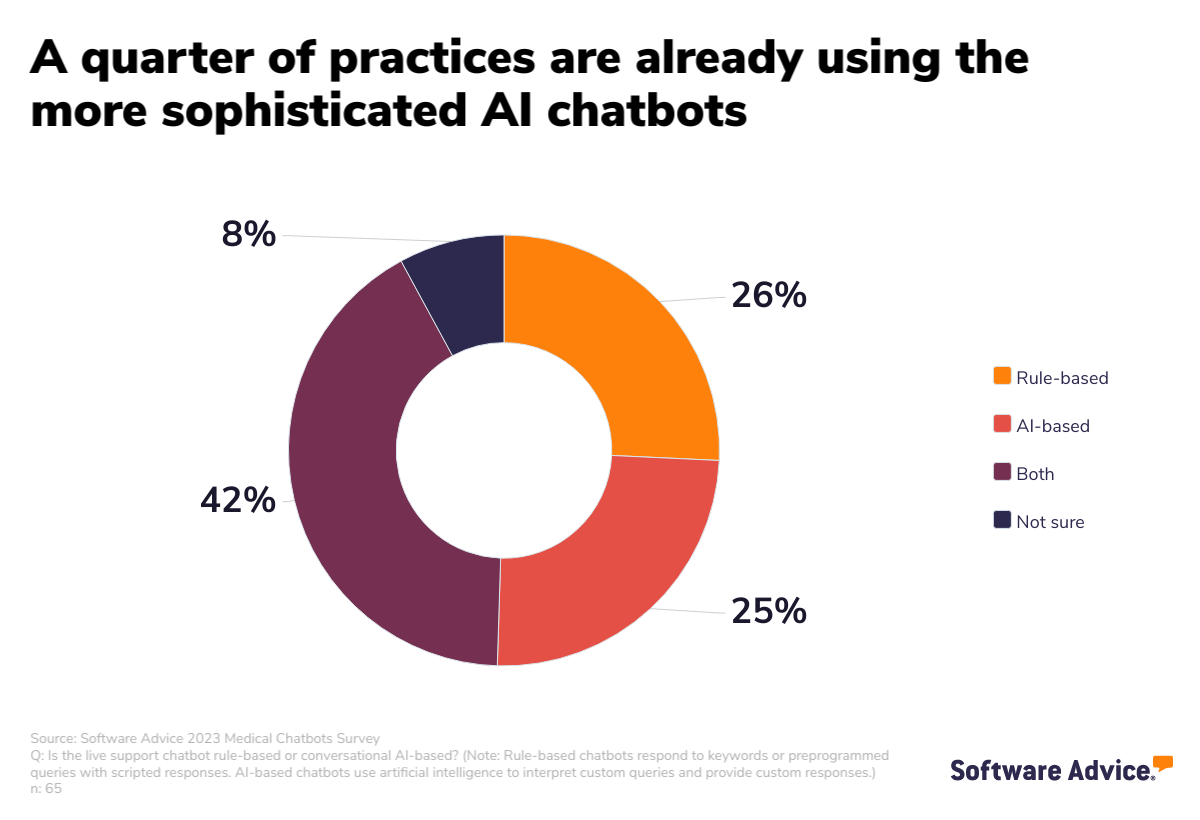
We also discovered that 92% of practices host chatbots on their websites, and the majority of practices make them available to patients around the clock. But a surprising 15% only allow the chatbots to operate during their business hours, which means these practices aren’t maximizing these tools to their full potential by allowing them to field patient inquiries while employees are off the clock.
The most common uses for chatbots include administrative tasks, with patient self-scheduling being the number one application. By allowing chatbots to function around the clock, practices can enable patients to complete necessary administrative tasks without requiring a human to be awake and on the clock to facilitate these tasks.
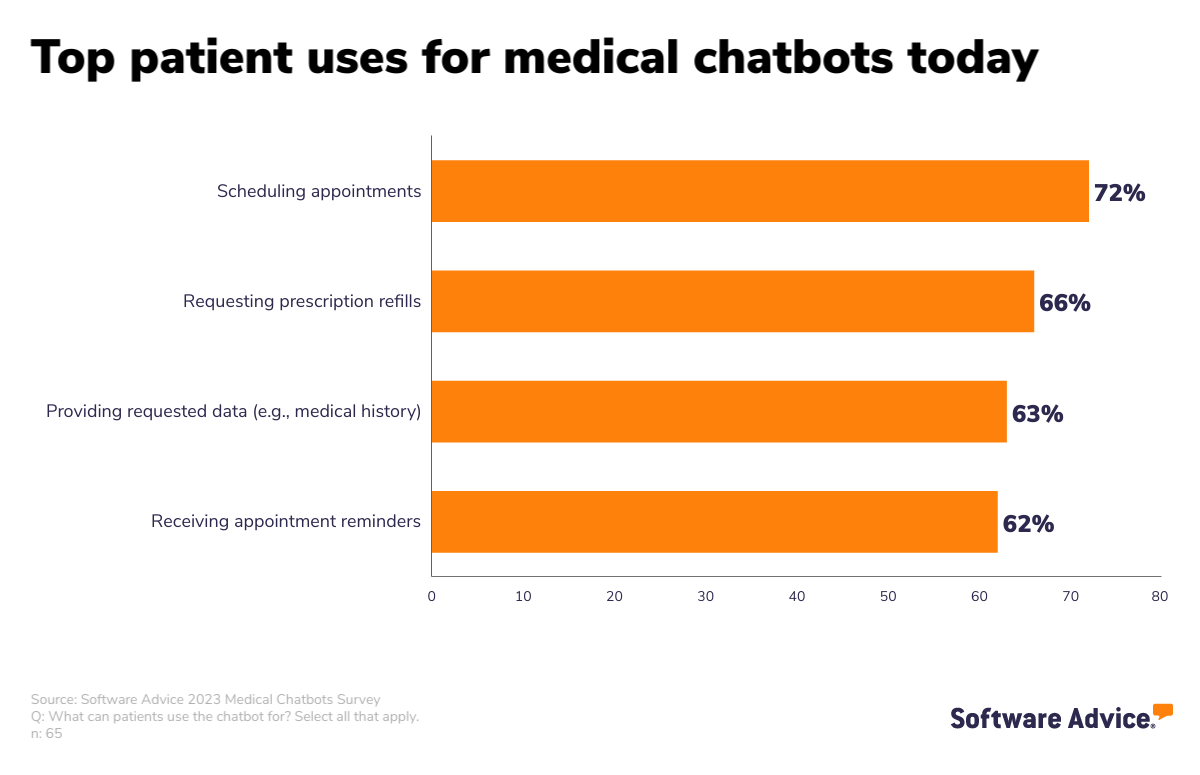
Even though physicians in our survey have a good deal of faith in their chatbots, limiting the most common uses for chatbots to administrative tasks makes sense.
ChatGPT may have passed the U.S. Medical Licensing Exam [3], but only just. And that certainly doesn’t mean all chatbots are ready to start providing treatment plans without the supervision of a qualified human.
With that said, 46% of practices are already using their chatbots to assess patient symptoms and help with triage, and this specific area holds a ton of promise for clever AI tools in the future.
Chatbots today are already valuable time-saving tools
Based on our research, it’s obvious today’s chatbots are most valuable as time-saving tools, thanks to the administrative tasks they can handle without requiring human supervision. For example, we found that 55% of practices who use chatbots for patient self-scheduling are saving time by doing so.
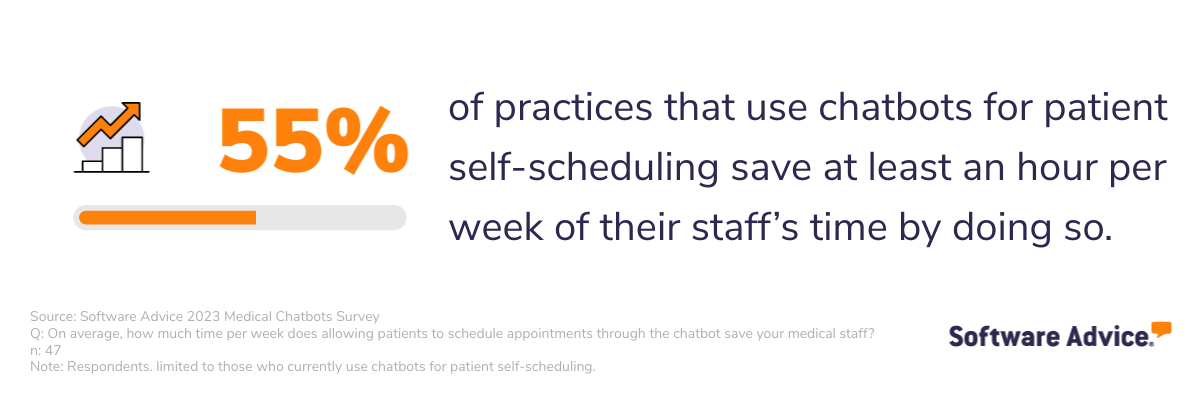
We also learned that chatbots are resolving around 46% of patient inquiries, on average, without needing to escalate those cases to a staff member. While this is one area I predict a lot more growth in, it’s already saving practices a ton of time and energy by handling easier patient queries and administrative situations.
Thanks to these and other benefits, 68% of practices are reporting a positive ROI for their chatbots, and 95% are satisfied with their chatbot right now.
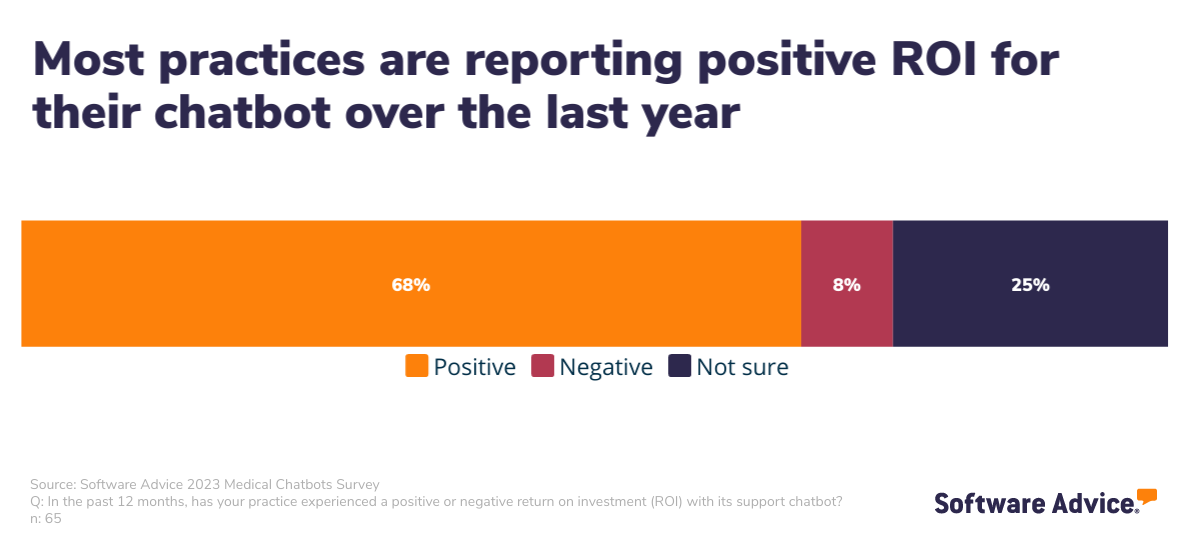
The lesson here is clear: If you aren’t already using a chatbot, you should be.
Even a simple rule-based chatbot can save you time by fielding simple patient inquiries, and these tools are incredibly easy to integrate into existing websites or social media platforms.
If you’re still not ready to invest, though, you need to decide what your practice’s tipping point is. For that, we have to look at what’s being done on the bleeding edge of this technology in order to predict what AI chatbots will reasonably be able to do in the future and how long it will take them to be able to do those things well.
Chatbots tomorrow will be absolutely necessary
Nearly half of practices using chatbots allow their software to collect patient symptoms and assess them, escalating urgent cases and advising patients how to handle the less severe symptoms.
As developers get better and better at teaching AI how to learn, this percentage will go way up. The next step is more ubiquitous use of AI chatbots as triage tools to sort urgent and non-urgent cases, better managing the demands on doctors’ time and attention.
Case in point: an astounding 77% of doctors say they are confident in their chatbot’s ability to accurately assess patient symptoms right now.
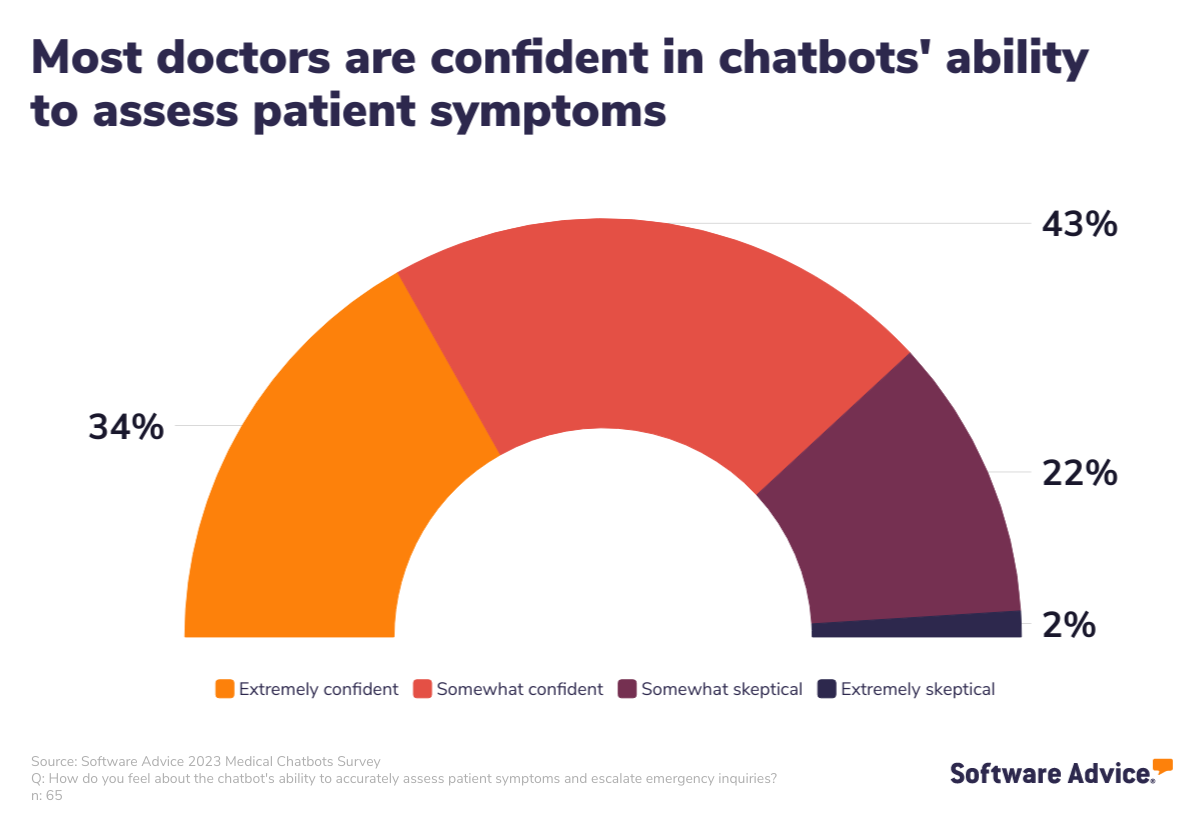
Because of the impact ChatGPT’s release had on this conversation, we also wanted to hear from doctors who have directly interacted with that specific platform. Of the 42 doctors in our survey who have used ChatGPT, only one said they didn't believe the advancements in AI technology exhibited in the software will lead to significant improvements in healthcare.
The majority (45%) believe ChatGPT is a useful tool for doctors today, without the need for any adjustments. And 77% believe AI-powered chatbots will develop to the point of being able to safely treat patients within the next 10 years.
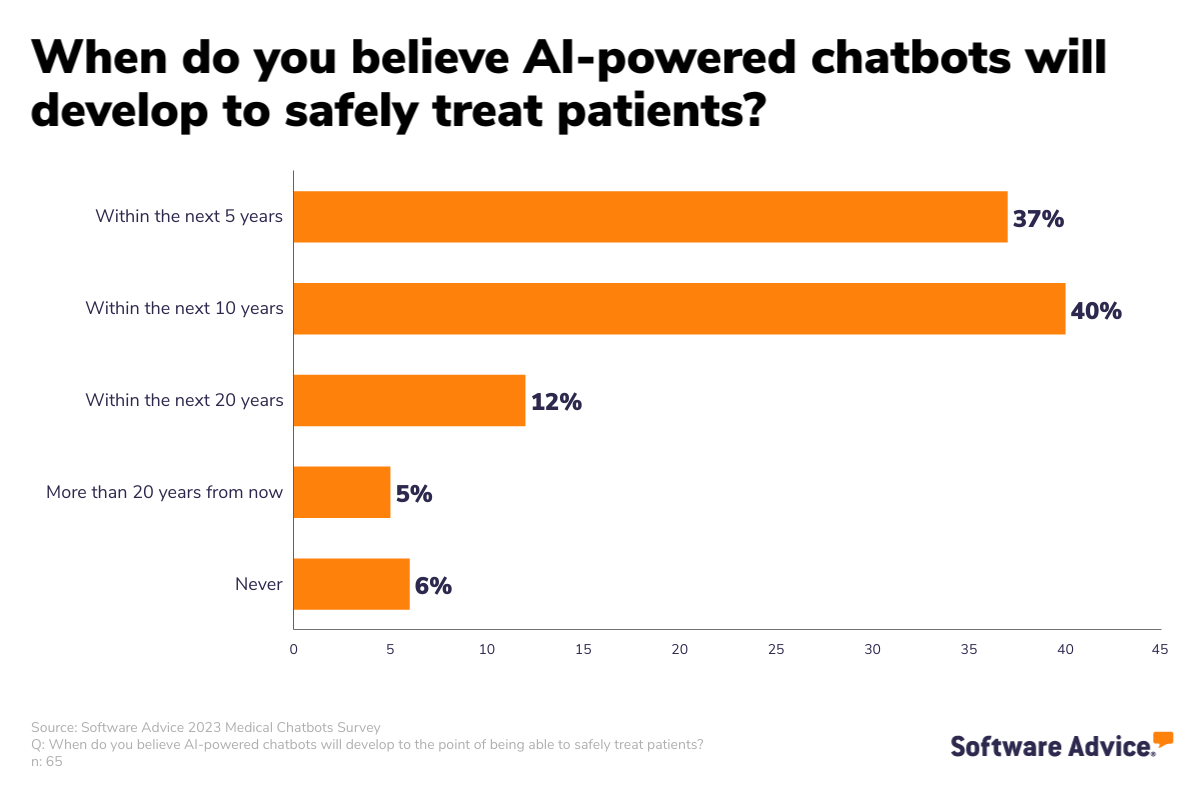
What chatbots treating patients could look like in the future isn’t exactly defined yet, but the most likely scenarios include assessing patient symptoms for more common illnesses (e.g., sinus infections) and prescribing normal medications to address it.
While we’re unlikely to see robots giving patients shots anytime soon, qualified chatbots will be able to take in information about symptoms, as well as patient biometric data, history, drug allergies, etc., and then produce treatment plans similar to what human doctors do in these situations.
Even if we step away from the idea of AI actually treating patients, we can clearly see value in this technology. AI will be valuable for educating future doctors, assisting and conducting medical research, advancing diagnostic methods, and engaging patients in their care.
So, is AI going to take your job?
It’s worth noting that a lot of the conversation sparked by ChatGPT’s release and subsequent academic mastery [4] has been fearful. As we watch AI grow more and more advanced, it's understandable to ask: "Should I be afraid that AI chatbots are going to replace me, or my job?"
The short answer is no, that’s not at all likely.
As we learned from Dr. Stermer[1], generative AI still needs a qualified human to double-check its work before submitting any paperwork.
Even as it develops to the point of requiring less double-checking, there will still be the matter of human reluctance to overcome. I don’t expect patients to completely trust an AI doctor right away, so human professionals will need to give the final OK on all medical treatment plans for a long time to come.
Additionally, teaching AI how to keep up with every piece of new data or research in medicine is not an entirely simple (or cheap) task. It takes energy—literally megawatts of it—to run ChatGPT. And as medical knowledge continues to grow at exponential rates, so too will the cost of running generative AI platforms.
So where does that leave you?
How to prepare for future AI chatbots
Early adoption is a smart move. As we’ve learned, chatbots currently on the market are excellent tools for saving time, which is something that can go a long way toward keeping your staff happy.
Not only will it save you time and money today, but it will also help you keep an ear to the ground as chatbot platforms begin to adopt more advanced learning techniques and language models for their AI. If that interests you, you can start by comparing existing chatbot platforms to find the best fit for your practice.
If you’d rather wait and learn more before investing, you can do so by exploring these resources:
3 Benefits of Artificial Intelligence in Healthcare You Should Know About Right Now
Use Patient Preference to Improve Patient Care Through Technology
We know for a fact that this technology will continue to be developed, so those who resist it are only hurting themselves.
Survey methodology
*Software Advice’s 2023 Medical Chatbots Survey was conducted in March 2023 of 65 doctors, therapists, or practice owners/founders who currently use live chatbots on their websites. The purpose of this survey was to gauge awareness of AI-powered chatbot tools, assess the most valuable applications in use today, and find out how doctors feel about the potential of AI-powered chatbots like ChatGPT to help manage and run a medical facility.
We used screener questions to narrow respondents down to doctors, therapists, or practice owners/founders with relevant experience related to chatbots.
Sources
This Doctor Is Using a Chatbot For Prior Authorizations, Op-Med
DocsGPT in beta targets physician burnout, Healthcare IT News
ChatGPT Passes US Medical Licensing Exam Without Clinician Input, Health IT Analytics